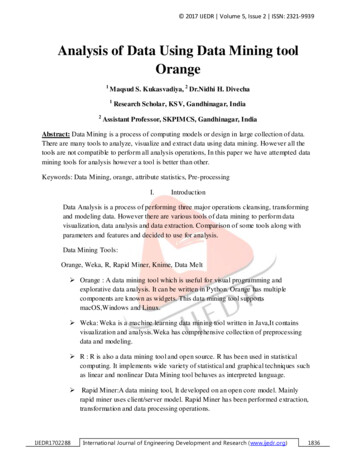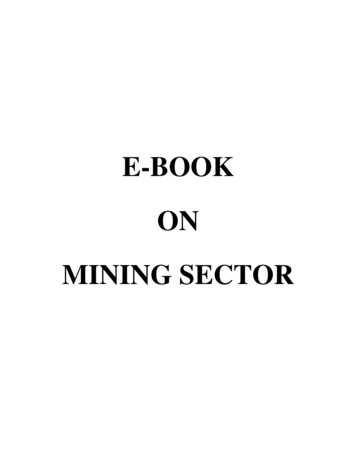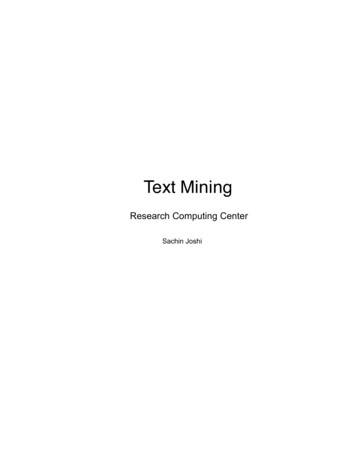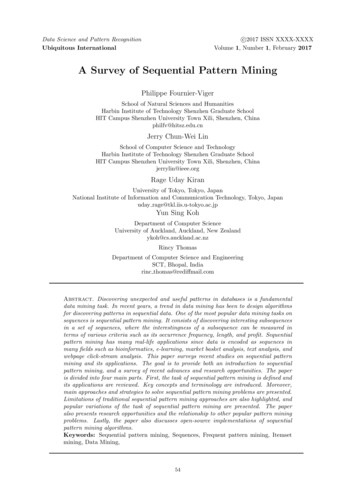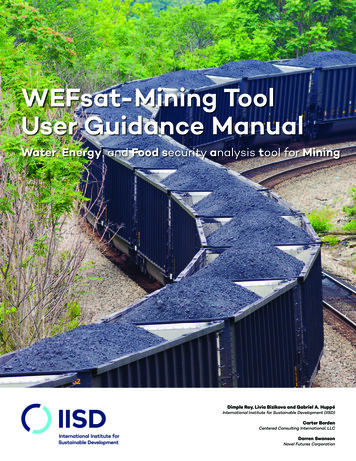
Transcription
WEFsat-Mining ToolUser Guidance ManualWater, Energy, and Food security analysis tool for MiningDimple Roy, Livia Bizikova and Gabriel A. HuppéInternational Institute for Sustainable Development (IISD)Carter BordenCentered Consulting International, LLCDarren SwansonNovel Futures Corporation
2015 International Institute for Sustainable DevelopmentPublished by the International Institute for Sustainable DevelopmentINTERNATIONAL INSTITUTE FOR SUSTAINABLE DEVELOPMENTThe International Institute for Sustainable Development (IISD) isone of the world’s leading centres of research and innovation. TheInstitute provides practical solutions to the growing challenges andopportunities of integrating environmental and social priorities witheconomic development. We report on international negotiations andshare knowledge gained through collaborative projects, resultingin more rigorous research, stronger global networks, and betterengagement among researchers, citizens, businesses and policymakers.IISD is registered as a charitable organization in Canada and has501(c)(3) status in the United States. IISD receives core operatingsupport from the Government of Canada, provided through theInternational Development Research Centre (IDRC) and from theProvince of Manitoba. The Institute receives project funding fromnumerous governments inside and outside Canada, United Nationsagencies, foundations, the private sector, and individuals.WEFsat-Mining Tool User Guidance ManualWater, Energy, and Food security analysis tool for MiningSeptember 2015Written by Dimple Roy, Livia Bizikova, Gabriel A. Huppé, Carter Bordenand Darren SwansonACKNOWLEDGEMENTWEFsat-Mining was developed by the International Institute forSustainable Development (IISD) with funding from Foreign Affairs,Trade and Development Canada. Technical support was provided byCentred Consulting International, LLC and Novel Futures Corporation.Head Office111 Lombard Avenue, Suite 325Winnipeg, ManitobaCanada R3B 0T4Tel: 1 (204) 958-7700Fax: 1 (204) 958-7710Website: www.iisd.orgTwitter: @IISD news
CONTENTS1. INTRODUCTION Purpose Context PART 1: WEFsat-MINING AT A GLANCE What is WEFsat-Mining? What Are the Steps in Using WEFsat-Mining? How to Use WEFsat-Mining? What Resources are Required to apply WEFsat-Mining? 11133457PART 2: WEFsat-MINING STEP-BY-STEP 8General Step 1: Understanding Community WEF Status and Linkages Worksheet #1 - Community profile Worksheet #2 – WEF Inventory Worksheet #3 – WEF Status-base Worksheet #4 – WEF System Diagram Step 2: Identifying Potential Mining Benefits and Impacts Worksheet #5 – Mining Profile Worksheet #6 – WEF Inventory Mine Worksheet #7 – Mining WEF Influence Step 3: Exploring Actions and Indicators Worksheet #8a & 8b – WEF Security Actions and Indicators Worksheet #9 – Mining Influence Diagram Step 4: Summarizing for Decision-Makers Worksheet #10 – Summary for Decision-Makers Guidance for Expert Users Properties Tab Indicator Reference Tab 889101213141415172222252626282831ADDITIONAL INFORMATION Contact Information Resources and References 333333WEFsat-Mining Tool User Guidance Manual III
ContentsFIGURESFigure 1. IISD’s WEF Security Analysis Framework Applied to the Assessment of Potential Mining Benefits and Impacts Figure 2. The WEFsat-Mining Methodology Figure 3. Worksheet #1: Community Profile Figure 4. Worksheet #2: WEF Inventory Base Figure 5. Worksheet #3: WEF Status-Base Figure 6. Worksheet #4: WEF Diagram Base Figure 7. Worksheet #5: Mine Profile Figure 8. Worksheet #6: WEF Inventory-Mine Figure 9. Worksheet #7: WEF-Influence-Mine Figure 10. Filter Menu Figure 11. Effect of Filters in Viewing Data Figure 12. Worksheet #8a: WEF Mine-Composite (Operations) Figure 13. Indicator Selection Dialogue Box Figure 14. Worksheet #9: WEF Mine Diagram Figure 15. Worksheet #10: Executive Summary Figure 16. Functionality of Properties Worksheet, Part 1 Figure 17. Functionality of Properties Worksheet, Part 2 Figure 18. Functionality of Properties Worksheet, Part 3 Figure 19. Indicator Reference Tab. Note: Food indicators are listed to the right 56911121315171920212424252728293032TABLESTable 1. IISD’s Water-Energy-Food Security Analysis Framework. 4
1. INTRODUCTIONPURPOSEThe purpose of the Water, Energy and Foodsecurity analysis tool for mining (WEFsatMining) is to help identify the potential benefitsand impacts of mining on community-levelwater, energy and food (WEF) security to findthe most effective ways of managing acrossthese interlinked sectors. Users of the tool canexplore specific actions for realizing benefitsand mitigating actions as well as select anddevelop indicators for tracking the status of WEFsecurity and the progress of critical actions. Usersfamiliar with environmental and social impactassessment methods will find WEFsat-Miningintuitive and a welcome addition to their toolkitfor understanding key relationships in achievingsustainable development.CONTEXTThe Intergovernmental Forum on Mining, Minerals,Metals and Sustainable Development, a networkof governments, industry and various interestgroups in 48 countries, put forth its Mining PolicyFramework (MPF) in 2014. The MPF calls for anoptimal conversion of natural capital into humancapital, the management of the natural resourcebase within ecosystems and continuous planningfor the post-mining transition, among otheraspects.Concurrently, the World Economic Forumhas consistently ranked WEF security issuesamong the top global risks facing governmentsand businesses around the world, noting that“any strategy that focuses on one part of thewater-energy-food nexus without consideringits interconnections risks serious unintendedconsequences” (World Economic Forum, 2011).WEFsat-Mining is designed to help advance theunderstanding of both the risks and benefits ofmining operations on the interrelated issue of WEFsecurity as key aspects of human security andsustainable development.Population growth and economic prosperity areincreasing the demand for minerals and othernatural resources in unprecedented ways, placingintense localized pressures on ecosystem goodsand services, including water, energy and foodproduction and supply. Prominent events such asthe global food crises of 2008 and 2011, and anongoing series of energy and water shortages incountries around the world have demonstratedthe need for coordinated action to address WEFsecurity and their interlinked causes. As well, theyhave highlighted that a deterioration in the abilityof WEF systems to provide for the basic needs ofa population can lead to adverse socioeconomic,livelihood and human well-being effects.Mining development creates both pressures andopportunities for WEF security in a communityor a cluster of communities in the vicinity of themine site. Communities in developing countriesbenefit from mining developments in manyways, such as livelihood opportunities, but at thesame time are also threatened by the negativeimpacts of mining on basic necessities such asfood, water, energy and shelter. The well-being ofthese communities thus depends upon the abilityof community members to sustain or improvetheir way of life and standard of living amid theintroduction of mining developments in theirregion. For mining companies, this means ensuringthat the environment is sufficiently protected toallow these communities continued environmentalgoods and services such as clean water, plentifulfauna and flora, and quality food that is safefor human consumption. However, it also meansthat the financial benefits of mining are fairlydistributed, that local people can partake inWEFsat-Mining Tool User Guidance Manual 1
1. Introductioneconomic and employment opportunities, thatlocal communities are empowered to participatein decisions that affect their well-being, and thatinfrastructural developments (e.g., roads, bridgesand water supply) are optimized with the needsof local populations in mind so as to maximizemutually beneficial outcomes. From a sustainabledevelopment perspective, it means balancing theexpectations and needs of the mining companyand its neighbours to ensure the long-termsustainability of linked social, economic andenvironmental systems affecting overall wellbeing.
PART 1: WEFsat-MINING AT A GLANCEWHAT IS WEFsat-MINING?WEFsat-Mining is IISD’s tool to understand theinterface of WEF and mining that draws onthe IISD Water-Energy-Food (WEF) SecurityFramework (Bizikova et al., 2013). This frameworkwas designed to support practical planningand decision-support processes for landscapeinvestment and risk management in theagricultural sector. Informed by a comprehensiveliterature review, this framework enables aplace-based analysis of four main componentsthat focus the obvious and underlying factorsaffecting a community’s ability to be WEF secure:access, availability, supporting resources andsupporting policies, and each in the context of aregion’s water, energy and food supply (Bizikovaet al., 2013). WEFsat-Mining seeks to facilitatethe operationalization of this framework in thecontext of mining with a focus on understandingand managing the benefits and impacts of miningon community-level WEF security.The framework (Figure 1) begins with ananalysis of how water, energy and food areavailable to households and communities inthe study context. This requires considerationof five aspects: (a) sources and production (i.e.,surface and groundwater, sources of energy andfood production); (b) water treatment, energyconversion and food processing; (c) storage ofwater, energy and food supplies; (d) modes ofdistribution of water, energy and food supplies;and (e) markets (both formal and informal) forwater, energy and food.households and countries. Or is access gainedthrough a combination of purchasing power(income, remittances from family members inother countries, credit), aid, self-production andbarter, as is often the situation in lower-incomehouseholds and countries?It is then necessary to understand the typesof supporting infrastructure that are relied onto ensure the access and availability of water,energy and food. Supporting infrastructure is oftwo types: (a) built infrastructure, referring tomanmade systems including communication,transportation and waste/sanitation systems and(b) natural infrastructure, including the ecosystemgoods and services associated with erosioncontrol, storm protection, water purification,biological control, air quality maintenance andpollination.The final component of the analysis frameworkrequires identification of institutions and policiesthat directly and indirectly support the naturaland built infrastructure needed to ensure accessand availability of WEF sources in a communityand region. This component is further brokendown into two categories, namely: (a) supportinginstitutions, including utility boards, userassociations and resource co-ops, education andtraining, safety oversight, law enforcement andsecurity; (b) supporting policies and plans relatingto resource use, climate change adaptation,disaster recovery and risk management, andresearch and development (R&D) and innovation.Central to the analysis framework is anunderstanding of how households (andcommunities of households) gain access towater, energy and food. Is it mostly throughtheir purchasing power (i.e., earned income),as is typically the case in higher-incomeWEFsat-Mining Tool User Guidance Manual 3
Part 1: WEFsat-Mining at a GlanceFRAMEWORK FOR ASSESSING WATER, ENERGY AND FOOD SECURITYSECURITY CATEGORYAvailabilityWATER SOURCESENERGY SOURCESFOOD essPurchasing Power (livelihood income, remittances, credit)Aid (direct provision, safety nets, subsidies)Self-Production (water wells, off-grid power, individual/community gardens)BarterSupporting InfrastructureBuilt Infrastructure (transportation, communication, waste removal)Natural Infrastructure (ecosystem services such as: erosion control, storm protection, waterpurification, biological control, air quality maintenance, pollination)Supporting Institutions andPoliciesInstitutions (utility boards, user associations and resource co-ops, education and training,safety oversight, law enforcement and security)Policies & Plans (resource use, climate change adaptation, disaster recovery, risk management,research, development (R&D), and innovation)Table 1. IISD’s Water-Energy-Food Security Analysis Framework.Source: IISD (2015)WHAT ARE THE STEPS IN USINGWEFsat-MINING?The WEF security analysis tool for mining(WEFsat-Mining) is a Microsoft (MS) Excelbased tool designed to help identify the potentialbenefits and impacts that a proposed or existingmining operation has on WEF security.The first step of WEFsat-Mining assessesthe current status of each of the frameworkcomponents for the community (or aggregationof communities) in question and how they areconnected. The second step involves identifyingall of the possible benefits and impacts that eachof the mining components (e.g., mine operations,ore processing, general operations) might have oneach of the WEF security components and theircombination. This necessitates the identificationof all the individual mining componentscomprising the proposed or existing miningdevelopment during operation and closure phases.After gaining an understanding of the potentialmining benefits and impacts on each of theWEF security components, the third step of theassessment includes identifying specific actionsthat are necessary to help realize the potentialbenefits associated with mining’s influence,or mitigate the potential impacts as well asindicators for tracking the status of WEF security
SECURITYCOMPONENTSENGAGEMENT AND ASSESSMENTAvailabilityAccess1. Status and linkagesSupportingInfrastructure (Builtand Natural)SupportingInstitutions andPolicies2. Potential miningbenefits and impacts3. Actions to realizebenefits and mitigateimpacts4. Summary fordecision-makersINDICATORS AND MONITORINGFigure 1. IISD’s WEF Security Analysis Framework Applied to the Assessment of Potential Mining Benefits and Impactsand progress toward key actions. Finally, step fourattempts to summarize all of this information fordecision-makers.Addressing the assessment questions is onlypossible through iterative deliberation withpersons who are involved in implementing miningoperations and are involved in any capacity insecuring water, energy and food in their vicinity.The deliberative process using WEFsat-Mining istypically a combination of one-on-one meetings,virtual correspondence and multi-person workshopsettings. Given this, using WEFsat-Mining in adeliberative process and setting should be led bya facilitator trained in the use of WEFsat-Mining.For information about training opportunities,contact the International Institute for SustainableDevelopment (IISD) at info@iisd.ca.HOW TO USE WEFsat-MINING?WEFsat-Mining engages stakeholders in anassessment of: (i) the current status (and linkages)of the availability of and access to water, energyand food, and the array of infrastructure (builtand natural) and policies that support their use;(ii) the potential benefits and impacts of miningon these WEF security components; and (iii) theactions necessary to realize potential benefits andmitigate impacts. The tool also helps users identifyindicators that can be used to track the statusand trends of WEF security components and thepotential mining benefits and impacts, along withprogress toward key actions.WEFsat-Mining consists of 10 worksheets tofacilitate a comprehensive assessment of WEFsecurity in the context of a specific communityor collection of communities, as influenced by anexisting or proposed mining operation (Figure 2).A summary of each of the 10 worksheets isprovided below.WEFsat-Mining Tool User Guidance Manual 5
Part 1: WEFsat-Mining at a GlanceSECURITYCOMPONENTSENGAGEMENT AND ASSESSMENTStatus and linkagesAvailabilityAccessSupportingInfrastructure (Builtand Natural)1.CommunityProfile2.WEF Inventory(Sources, Uses)3.WEF Status(current)4.SupportingInstitutions andPoliciesPotential miningbenefits and impacts5.Mining Profile6.Mining WEFInventory (Source,Uses)7.Mining WEFInfluenceWEF SystemDiagramActions to realizebenefits and mitigateimpacts8.WEF SecurityActions &Indicators9.Mining InfluenceDiagramSummary forDecision-makers10. WEF SecuritySummaryINDICATORS AND MONITORINGFigure 2. The WEFsat-Mining MethodologyStep 1: Status and Linkages Users describe the current status of WEF systemsin terms of the characteristics of the variousaffected communities, how these communitiesmake use of different energy sources and how theWEF systems are interlinked in this context. Worksheet #1 – Community Profile: To identifyand describe the communities that are situatedwithin the WEF systems of the existing orproposed mining operation.Worksheet #2 – WEF Inventory: To identify thesources and uses of water, energy and food inthe communities and the linkages among them(i.e., electricity used to power water pumps thatare used to irrigate crops).Worksheet #3 – WEF Status: To describe thecurrent status of the WEF security componentsrelevant to each WEF source (i.e., availability,access, supporting infrastructure [built andnatural], and supporting institutions andpolicy).Worksheet #4 – WEF System Diagram:A systems-mapping palette to enable afacilitator to work with stakeholders to drawand visually represent the existing sources anduses of water, energy and food and how theyare linked.Step 2: Potential Mining Benefits and ImpactsUsers describe the influence of different miningactivities and processes at the operations andclosure phases of the mine on the WEF system inthe communities. Worksheet #5 – Mining Profile: To describethe characteristics of the existing or proposedmining development at two specific pointsin time: full operations and full closure. Thetemporal perspective is important, as thepotential benefits and impacts of mining maybe different during operations and after themine closes. Worksheet #6 – Mining WEF Inventory: Todescribe any new water, energy and foodsources introduced by the mine, as well as thenew uses resulting from the mine.
Worksheet #7 – Mining WEF Influence: Toidentify the potential benefits and impacts ofmining (during both operations and closure)on the availability and accessibility of keysources of water, energy and food, as wellas the supporting infrastructure (both builtand natural) and supporting institutions andpolicies.Step 3: Actions and IndicatorsUsers identify actions to address the impactsand benefits of mining to preserve and improveWEF security, and indicators to assess and trackprogress in the WEF system. Worksheet #8 – WEF Security Actions andIndicators: This worksheet compiles all of thepotential benefits and impacts of mining inone place and enables stakeholders to worktogether to identify key actions to help realizepotential benefits and mitigate impacts ofmining. This sheet also provides menus ofpossible indicators that could be used to trackthe status and trends of the WEF securitycomponents as well as the potential miningbenefits and impacts, and progress towardnecessary actions.Worksheet #9 – Mining Influence Diagram:This worksheet is the same as the WEF SystemDiagram Worksheet #4 and provides a canvasto incorporate and visually depict the specificinfluences of mining development on theoriginal WEF security system.Step 4: Summary for Decision-MakersUsers identify and summarize the key insightsuncovered throughout the use of the tool withregards to each component of WEF security. Worksheet #10 – Summary for DecisionMakers: This worksheet compiles the informationfrom the previous worksheets into a summaryformat. Show and hide buttons enable users toselect which information to display.Part 2 of this User Guidance Manual takes usersstep-by-step through each of these worksheets.WHAT RESOURCES ARE REQUIREDTO APPLY WEFsat-MINING?The resources required to use WEFsat-Mining varyaccording to the objectives and capabilities of theusers. Depending on the availability of informationand experts on a range of topics and motivation,such an analysis will take between two to sixweeks to conduct all the steps in a deliberativemanner, which includes some time for preparation,stakeholder consultations, data entry into the tooland data analysis. Costs will vary accordingly andare generally related to project team meetings andstakeholder consultations.WEFsat-Mining Tool User Guidance Manual 7
Part 2: WEFsat-Mining Step-by-StepPART 2: WEFsat-MINING STEP-BY-STEPGENERALExample workbook:Installing WEFsat-Mining on a computer: Download the MS Excel-based tool from theIISD website here. Note: the WEFsat-Miningtool has been constructed in MS Excel v2010.Users of MS Excel for iOs systems and OpenOffice should use with care, as the tool hasnot been tested on these platforms.Navigating through WEFsat-Mining: The tabs at the bottom of the Excel workbookcan be navigated in sequential fashion totake users through the necessary componentsof the tool. The colours of these tabs areassociated with each of the four steps of thetool, to which individual worksheets belong.Entering and updating information: WEFsat-Mining is flexible; you can navigateback and forth among the different pages atany point in the process to revise, update andchange information as needed.While the application does not have a wordlimit for the information to be entered inthe different boxes, the user should be asspecific as possible and use precise, concisesentences, as the information you insert willbe automatically transferred across differentworksheets.Getting help and guidance: The User Guidance Notes found near the topof each worksheet provide guidance on how tofill in individual sections of the tool. Click onthe User Guidance Notes, and a comment boxwill appear containing information of use tothose seeking further clarification.An example MS Excel workbook has beencreated entitled WEFsat-Mining ExampleWorkbook.xlsm here. This workbook presentsa fictitious set of communities and miningdevelopment in order to demonstrate thetype of content that is input and producedby the tool.STEP 1: UNDERSTANDINGCOMMUNITY WEF STATUS ANDLINKAGESIn this first step, users describe the currentstatus of WEF systems in terms of thecharacteristics of the various affectedcommunities; how these communities makeuse of different water, energy and food sources;and how the WEF systems are interlinked in thiscontext.WORKSHEET #1 - COMMUNITY PROFILEObjective. To identify and describe thecommunities that are situated within theWEF sheds of the existing or proposed miningoperation. Up to five communities can be profiled,with an average profile calculated in the lastcolumn. Aside from the community names, thisprofile information is not directly linked to theother worksheets as input, but is necessary to beable to properly address the rest of the analysisquestions in the tool.Process. Enter some basic information about thecommunities you wish to examine through thelens of WEF security (Table 1). This informationincludes:
General: Information about the demographicsand location of the communities. Water Use: Information about the sources ofwater that communities depend on. Livelihoods: Information about the reliance onmining employment versus other sources ofincome in the community. Energy Use: Information about access to theelectric grid and sources of self-producedelectricity. Land Use and Food Consumption: Informationabout the use of land and the sources of foodthat communities depend on.Figure 3. Worksheet #1: Community ProfileWEFsat-Mining Tool User Guidance Manual 9
Part 2: WEFsat-Mining Step-by-StepWORKSHEET #2 – WEF INVENTORYObjective. To identify the sources and uses ofwater, energy and food in the communities andthe linkages among them (i.e., electricity usedto power water pumps that are used to irrigatecrops). This worksheet thus creates a baselineinventory of existing WEF sources and uses in thecommunity(ies) of interest AND identifies the keylinks between these WEF sources and uses.Process. Use the column group hide/unhide tabsat the top of the worksheet to hide or show theInventory and Connections information. To exposecolumns, select the “ ” above the columns and tohide columns, select the “-” at the top of the page(Figure 4). Start by displaying only the Inventoryinformation and, when finished, unhide andcomplete the Connections information.From the drop-down menu in cell C3, select aspecific community or the average communitydescribed in Worksheet #1. The questions in thisand the remaining worksheet must be addressedfrom the perspective of either a specificcommunity within the mine’s WEF shed or anaverage representation of several communities.Completing the InventoriesStarting with the Water Section, follow thisprocedure:1.Rank Use: in Cell C8 is the relative quantity ofwater for each of the Uses. Rank each of theUses by either an integer (1, 2, 3, with 1 beingthe highest use) or the percentage of the totalwater used in the community (e.g., irrigationuses 75%, domestic 20% and agriculture 5%).2. Percentage of Sources: Fill in the percentagethat each Source supplies each Use. Thepercentage of all the Sources should total100% at the bottom of each Use column toensure all the Sources have been identified.Sources that are significant (i.e., greaterthan 5% by default) will be labelled witha “Y” in the Relevant column (column L).Note: effort should be given to provide anaccurate percentage of each Source, butthese numbers are not linked to other parts ofthe tool, so approximate or best guesses aresufficient. The information provides contextfor addressing the questions in the remainingsheets.3. Use Descriptions: For each Source manually fillin the Use Description in column M.4. Repeat steps 1–3 for the Energy and Foodsections.Completing the ConnectionsFor Sources that are flagged as significant in theRelevant column (column L), identify and describethe relevant connections to the other Sourcesusing the following steps:5. Identifying Source connections: Select theSource Code of the other sources that areconnected. Drop-down menus in columns S,V and Y contain the Source Codes. If multiplesources support the active Source choose thedominant Source and list the others in thedescription cell. Comments contained in theheader titled Key at the top of the columncontain a list of Source Codes.6. Identify the connection direction: Fromthe drop-down menu, choose 1 (enabling,an upward arrow) if the connected Sourcehelps to make the source available, or -1(consuming, downward arrow) if the connectedSource actually results in some consumptionof the active Source. A value of zero denotesno connection and is represented by a circle.Comments associated with the header titledKey at the top of the column describe whatthe numerical values represent.7.Description: For each connection, providea narrative to elaborate the nature of theconnection.
For more detailed guidance on how to use the WEFInventory worksheet, refer to the comments in thetool’s User Guidance Notes cell located near thetop of the worksheet.Figure 4. Worksheet #2: WEF Inventory BaseWEFsat-Mining Tool User Guidance Manual 11
Part 2: WEFsat-Mining Step-by-StepWORKSHEET #3 – WEF STATUS-BASEObjective. To describe the current status ofthe WEF security components relevant to eachWEF source (i.e., availability, access, supportinginfrastructure [built and natural], and supportinginstitutions and policy).Process. For each relevant WEF source identifiedin Worksheet #2, input descriptions for the currentstate of each of the WEF security componentsin column A (see the Introduction Worksheet fordefinitions).To facilitate the completion of the worksheet,hide Sources that are not significant. Sourcesthat were identified as relevant in Worksheet #2have a “Y” flag beside the Source name in row 7.All other Sources on this sheet—those with an “N”flag—can be hidden by selecting the columns andright-clicking the Hide tab. This cleans up the viewof the sheet to include only those columns thatrequire input.Figure 5. Worksheet #3: WEF Status-BaseFor each relevant Source column, identify thestatus of the WEF components (rows) as follows:1.Flag the importance of the WEF component.Flag the importance of each WEF componentto the Source using the drop-down menus incolumns D, U, etc., as either a “0” (componentnot important for this source); “1” (somewhatimportant); “2” (important); or “3” (componentvery important to this source). The flag incolumn B reveals the maximum importance forall Sources for that specific WEF componentrow (rows can be hidden to show only thosewith a specific relevance threshold).2. Describe the status of the WEF component.In the adjacent cell, input text to describe thecurrent state of the component in qualitativeand/or quantitative terms.3. Repeat steps 1 and 2 for all relevant Sourcecolumns.
WORKSHEET #4 – WEF SYSTEM DIAGRAMObjective. A systems-mapping palette to enablea facilitator to work with stakeholders to visuallyand collaboratively draw the existing sources anduses of water, energy and food and their linkages.Process. Based on the results from the WEFInventory Base (Worksheet #2), use the shapesin the palette (columns W-AK) to draw a systemsdiagram of the community’s WEF Sources andUses, including their connections (Figure 6). Thefigure below shows an illustrative diagram, butevery use will differ.To use the Palette, copy the shapes and drag themonto the drawing space.Note on participatory engagement: in aparticipatory setting, this diagram can be used asthe starting point for filling out Worksheet #2.Figure 6. Worksheet #4: WEF Diagram BaseWEFsat-Mining Tool User Guidance Manual 13
Part 2: WEFsat-Mining Step-by-StepSTEP 2: IDENTIFYING POTENTIALMINING BENEFITS AND IMPACTSIn this second step, users describe the influenceof different mining activities and processes at theopera
Worksheet #3: WEF Status-Base 12 Figure 6. Worksheet #4: WEF Diagram Base 13 Figure 7. Worksheet #5: Mine Profile 15 Figure 8. Worksheet #6: WEF Inventory-Mine 17 Figure 9. Worksheet #7: WEF-Influence-Mine 19 Figure 10. Filter Menu 20 Figure 11. Effect of Filters in Viewing Data 21 Figure 12. Worksheet #8a: WEF Mine-Composite (Operations) 24 .





